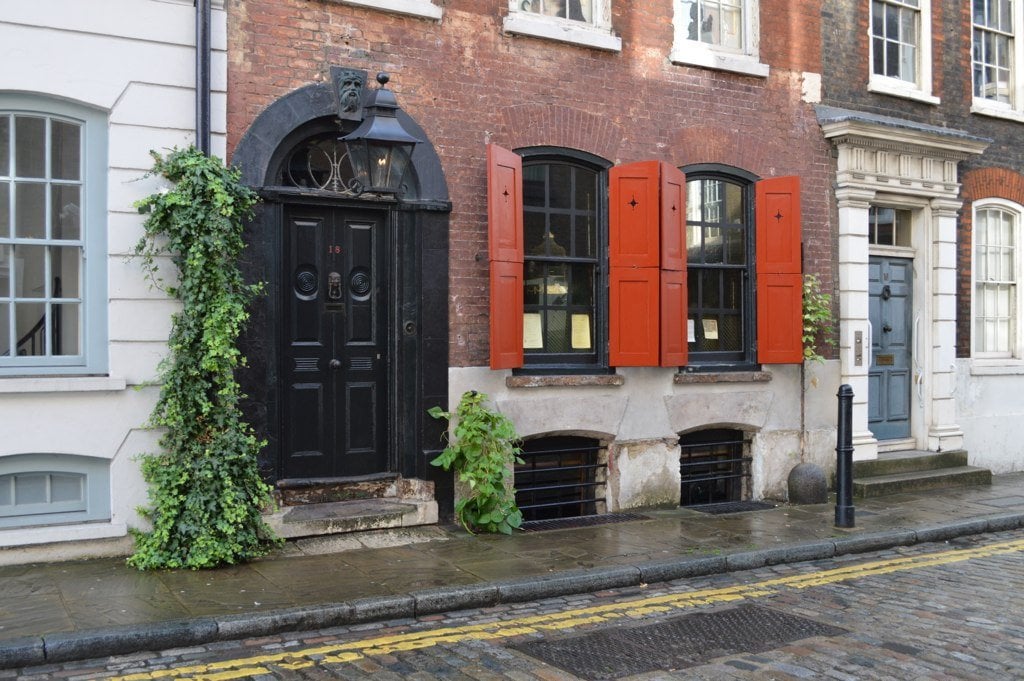Folgate Street is a narrow alley, tucked away in the heart of Spitalfields in London. Cobbled and flanked on both sides by teetering rows of terraced Georgian houses, it seems a perfectly preserved slice of the historic capital, as though pickled in some kind of invisible cultural formaldehyde.
That is, until you tilt your head upwards to gaze at the cool, glassy skyscrapers which cluster above, shadowing the little road with an intimidating confidence. Such is the inherent contradiction of this part of East London. It is an area deeply rooted in the past, home to crumbling brickwork and winding, gloomy alleys first inhabited by Huguenot silk weavers in the 17th Century. But the area is simultaneously the beating heart of modern Britain. After all, Old Street Roundabout, a mere five minute stroll from Folgate Street, is the UK’s unofficial answer to Silicon Valley.
Forty years ago however, Spitalfields had not yet been transformed by waves of iPad toting twentysomethings. On the contrary, as a result of bomb damage and decades of declining industry, this patch of London was more disheveled than ever before. However, it is precisely this dilapidation which prompted Dennis Severs to move into 18 Folgate Street in 1979. Severs grew up in Escondido, a small town in Southern California. Drenched in warm year-round West Coast sunlight, its wide boulevards and squat one-storey bungalows were about as far from Folgate Street as it was possible to get. But Severs, who would come home from school every day to watch British period dramas on TV, felt he had been born not just in the wrong country, but in the wrong era. He sought to turn his back on the present day. Folgate Street, in all its atmospheric disarray seemed the perfect stage on which to set the clock back.
Inside 18 Folgate Street, Severs set about perfecting his fantasy. He ripped out the electricity, plumbing and central heating, and redecorated the house, forcing his small corner of the world back into the past. In order to raise the funds necessary to maintain his unusual lifestyle, he decided to open the house to the public. It was Severs’ intention that as the visitor steps over the threshold of 18 Folgate Street, they should feel that they have passed not through a mere door, but through the very surface of a painting.
He dubbed this unique form of art ‘stilllife drama’. David Hockney described it as ‘one of the world’s greatest experiences’. Each room seems a canvas. A bowl of fuzzy apricots piled into a chipped china bowl in the kitchen is reminiscent of a Vermeer still life. The smoky quality of the light filtered through dusty windows in the dining room recalls Rembrandt. A pile of dirty linen casually heaped in a corner of the upstairs bedroom seems worthy of an oil painting in its own right. In one room, a Hogarth painting of a bawdy drinking scene is perfectly reflected by the room in which it hangs. Even an overturned glass of port splashed on the stained tablecloth echoes its two dimensional equivalent in the frame above. However, unlike the Old Masters, Severs’ canvases are alive: 18 Folgate Street is not merely a visual experience, but a multi-sensory one. The pungent smell of urine hovers around a chamber pot beside the bed. The faint sound of footsteps on the staircases above mingles with horse’s hooves on cobbles outside. A half-eaten Turkish Delight lies discarded next to a cup of coffee. The implication is that the house is still occupied. Notes scattered by Severs and family portraits hung around the house suggest that the inhabitants are a family of Huguenot silk weavers named Jervis.
Though they are only figments of Severs’ unusual imagination, the family seems undeniably present as you drift through the rooms. Here is where the motto of the house – ‘you either see it or you don’t’ – comes into play. “Still life drama” is a fine balancing act between the scene pre-prepared for the visitors, and the work the visitors must do themselves as they call on their imagination and suspend disbelief in order to fully participate in the living history of 18 Folgate Street.
Tours are conducted in silence, emphasising the responsibility of the visitor in enhancing their own experience. There is something eerie about the implication that you are visiting a house inhabited by ghosts, but there is equally an intimacy to the sense that the visitor has happened across these mundane domestic scenes, just at the moment that the inhabitants have left the room themselves.
The apparent constancies of family life throughout the centuries are also strangely tender: threads of hair tangled in a brush, an unmade bed, discarded children’s toys scattered across the floor. Dennis Severs’ house has been accused of being ahistorical. Indeed, the house is chaotic: below a Victorian bedroom, a Georgian dining room rubs shoulders with an Edwardian drawing room. There is a startling absence of factual information of any kind. But the result is that the experience at 18 Folgate Street is more emotive than a trip to a museum, and more immersive than a visit to an art exhibition. For a brief moment, Severs permits us to step through boundaries of the picture frame into the past.



